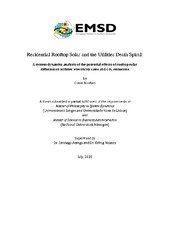Residential Rooftop Solar and the Utilities Death Spiral. A system dynamics analysis of the effects of rooftop solar diffusion on the electricity rates and CO2 emissions of the U.S. electricity supply sector
Master thesis
Permanent lenke
https://hdl.handle.net/1956/11613Utgivelsesdato
2015-08-12Metadata
Vis full innførselSamlinger
- Department of Geography [634]
Sammendrag
U.S. electric utilities are concerned by the recent exponential growth in rooftop solar installations among their customers. They fear that if their customers continue to adopt such self generation technologies and buy less electricity from the utility, then the utility will no longer make enough sales to achieve cost recovery' from these customers. Utilities argue that, in order to compensate for this, they will have to increase their electricity rates, and that these rate rises will in turn make self-generation technologies such as rooftop solar even more attractive. Such a situation results in a vicious loop, popularly known as the death spiral, whereby rooftop solar adoption results in rate increases, which in turn leads to more rooftop solar adoption. These rate rises would also be a social problem, as low-income families are statistically the least likely to install rooftop solar, and thus the most likely to suffer these rate rises the most. This study uses a system dynamics model to first analyze the validity of this death spiral' hypothesis in the context of residential rooftop solar and, secondly, to evaluate the policy of rooftop solar subsidies, based on their effects on (i) utility rates and (ii) reduction of CO2 emissions. Simulations reveal that the effect of rooftop solar on both utility rates and CO2 prevention is highly dependent on whether or not utilities claim/buy Renewable Energy Certificates for these privately owned rooftop solar systems, as part of meeting their Renewable Energy Portfolio. As a case study, the model uses data from the Salt River Project, a public owned utility based in Arizona.
